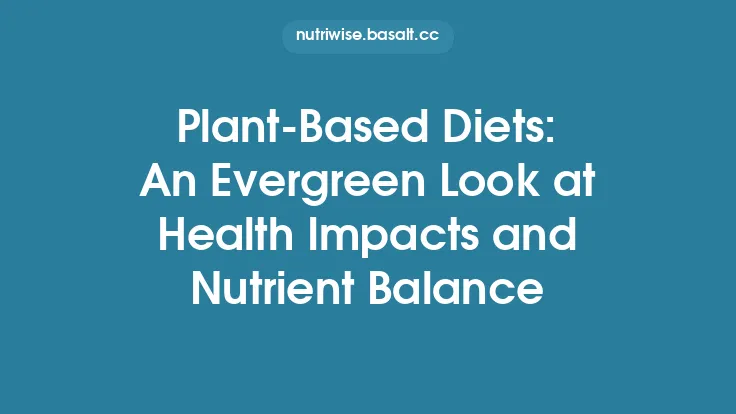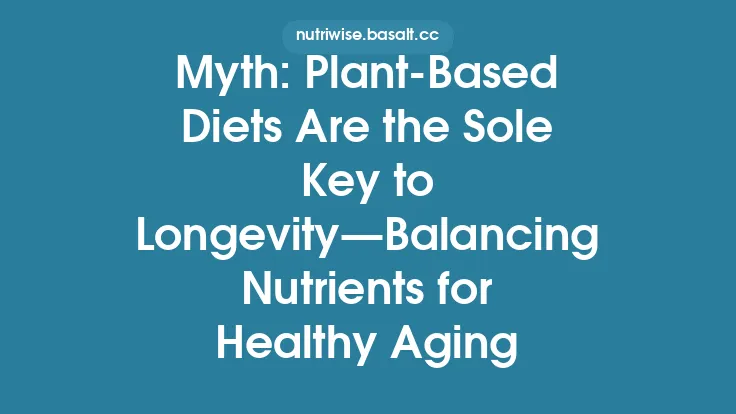Plant‑based eating has surged from a niche lifestyle choice to a mainstream dietary movement, championed by celebrities, social‑media influencers, and a growing body of scientific literature. Proponents tout a spectrum of benefits—from reduced chronic‑disease risk to lower environmental footprints—while critics warn of potential nutrient shortfalls and the rise of ultra‑processed “plant‑based” alternatives that may undermine health goals. This article offers an evidence‑based, critical appraisal of the plant‑based diet movement, weighing documented health advantages against plausible risks, and outlining practical guidance for those who wish to adopt the pattern responsibly.
Defining the Plant‑Based Diet Movement
The term “plant‑based” is often used interchangeably with “vegan” or “vegetarian,” yet subtle distinctions matter for both research interpretation and real‑world application.
| Category | Core Definition | Typical Food Choices | Exclusions |
|---|---|---|---|
| Vegan | Excludes all animal‑derived foods and ingredients. | Whole grains, legumes, nuts, seeds, fruits, vegetables, fortified plant milks, meat analogues. | Meat, dairy, eggs, honey, gelatin, animal‑derived additives. |
| Vegetarian | Omits meat but may include dairy and/or eggs. | Same as vegan plus dairy (lacto‑vegetarian) and/or eggs (ovo‑vegetarian). | All flesh foods. |
| Flexitarian / Semi‑vegetarian | Primarily plant‑centric but permits occasional animal products. | Predominantly plant foods; limited meat, fish, or dairy. | No formal limits; frequency varies by individual. |
| Whole‑Food Plant‑Based (WFPB) | Emphasizes minimally processed plant foods; excludes refined grains, added sugars, and most oils. | Whole fruits, vegetables, legumes, whole grains, nuts, seeds. | Highly processed plant foods, refined sugars, most added fats. |
| Processed Plant‑Based (PPB) | Commercially formulated products that mimic animal foods (e.g., soy burgers, pea‑protein “chicken”). | Plant‑protein isolates, texturized vegetable proteins, fortified emulsions. | Varies; often contains added sodium, preservatives, and refined oils. |
The modern plant‑based movement largely aligns with the first three categories, but the rapid proliferation of PPB products has blurred lines, prompting a need to differentiate health outcomes associated with whole versus processed plant foods.
Epidemiological Evidence for Health Benefits
Large‑scale cohort studies and meta‑analyses consistently link higher plant‑food intake with favorable health markers:
| Outcome | Representative Findings | Key Studies |
|---|---|---|
| Cardiovascular disease (CVD) | 15–30 % lower incidence of coronary heart disease among vegetarians vs. omnivores. | Satija et al., *JAMA Cardiology 2021; Dinu et al., Nutrients* 2019. |
| Type 2 diabetes | 20–35 % reduced risk; stronger effect when diet is rich in legumes, nuts, and whole grains. | Huang et al., *BMJ 2020; Barnard et al., Diabetes Care* 2022. |
| Cancer incidence | 10–20 % lower overall cancer risk; notable reductions for colorectal and breast cancers. | Tantamango‑Bartley et al., *JAMA Internal Medicine 2013; Aune et al., Lancet Oncology* 2020. |
| All‑cause mortality | 10–25 % lower mortality risk, especially when diet emphasizes whole plant foods. | Orlich et al., *JAMA Internal Medicine 2013; Schwingshackl et al., BMJ* 2019. |
| Weight management | Average 2–4 kg lower body weight and 0.5–1 kg/m² lower BMI in plant‑based cohorts. | Turner-McGrievy et al., *Obesity Reviews 2020; Wang et al., Nutrients* 2021. |
These associations persist after adjusting for confounders such as smoking, physical activity, and socioeconomic status, suggesting an independent contribution of plant‑centric eating patterns to health.
Mechanistic Insights: How Plant Foods Influence Physiology
Understanding *why* plant‑based diets confer protection helps translate epidemiological signals into actionable recommendations.
- Fiber‑driven microbiome modulation
- Soluble and insoluble fibers serve as prebiotics, fostering short‑chain fatty acid (SCFA) production (e.g., butyrate). SCFAs improve gut barrier integrity, reduce systemic inflammation, and enhance insulin sensitivity.
- Meta‑analyses show a dose‑response relationship: each 10 g increase in daily fiber correlates with a 5 % reduction in CVD risk (Miller et al., *Gut* 2022).
- Phytonutrient antioxidant capacity
- Polyphenols (flavonoids, carotenoids, lignans) scavenge reactive oxygen species, attenuate endothelial dysfunction, and modulate signaling pathways (e.g., NF‑κB).
- Randomized controlled trials (RCTs) of flavonoid‑rich diets report modest reductions in systolic blood pressure (−3 mm Hg) and LDL‑cholesterol (−5 mg/dL) (Rossi et al., *American Journal of Clinical Nutrition* 2021).
- Reduced saturated fat and cholesterol intake
- Plant foods contain negligible cholesterol and lower saturated fat, leading to decreased hepatic LDL‑receptor down‑regulation.
- Substituting 30 g of animal protein with plant protein reduces LDL‑C by ~0.1 mmol/L (Jenkins et al., *Circulation* 2020).
- Improved satiety signaling
- High‑volume, low‑energy‑density foods (vegetables, fruits) increase gastric distension and promote satiety hormones (PYY, GLP‑1), aiding weight control (Leidy et al., *Nutrition Reviews* 2019).
Potential Nutrient Gaps and Strategies to Mitigate Them
While whole‑food plant diets are nutritionally adequate when well‑planned, certain micronutrients warrant attention:
| Nutrient | Typical Concern | Plant Sources | Fortification / Supplementation |
|---|---|---|---|
| Vitamin B12 | Absent in plants; deficiency can cause neuropathy, anemia. | Fortified plant milks, nutritional yeast, fortified cereals. | Daily 2.4 µg B12 supplement for vegans (per NIH). |
| Vitamin D | Limited sunlight exposure; plant foods contain minimal D2/D3. | UV‑treated mushrooms (D2), fortified soy/almond milks. | 800–1000 IU vitamin D3 (vegan source) during winter months. |
| Omega‑3 (EPA/DHA) | ALA conversion to EPA/DHA is inefficient (<10 %). | Flaxseed, chia, walnuts (ALA). | Algal oil supplements providing 250–500 mg EPA/DHA. |
| Iron | Non‑heme iron has lower bioavailability; risk of anemia in high‑menstrual‑loss women. | Lentils, tofu, pumpkin seeds, dark leafy greens. | Pair with vitamin C‑rich foods; consider iron supplement if ferritin <30 ng/mL. |
| Calcium | Some vegans avoid fortified dairy alternatives. | Calcium‑set tofu, fortified plant milks, kale, bok choy. | Aim for 1000 mg/day; supplement if intake <800 mg. |
| Zinc | Phytate in legumes and grains can inhibit absorption. | Legumes, nuts, seeds, whole grains (soaked/fermented). | Soaking, sprouting, or fermenting grains improves bioavailability; supplement if plasma zinc <70 µg/dL. |
| Iodine | Variable in plant foods; seaweed intake may be inconsistent. | Iodized salt, seaweed (nori, kelp). | 150 µg/day iodine supplement if not using iodized salt. |
A practical approach combines diverse whole foods, strategic food preparation (soaking, sprouting, fermenting), and targeted supplementation when dietary intake falls short.
Processed Plant‑Based Products: Benefits, Pitfalls, and the Role of Food Technology
The explosion of plant‑based meat analogues, dairy alternatives, and snack foods has democratized access to vegetarian options but also introduced new nutritional considerations.
Potential Benefits
- Convenience & Palatability – May facilitate transition for omnivores reluctant to give up familiar textures and flavors.
- Protein Density – Isolated soy, pea, or wheat gluten proteins provide 15–20 g protein per 100 g, comparable to animal sources.
- Fortification Opportunities – Manufacturers often add B12, calcium, vitamin D, and omega‑3s, helping to close micronutrient gaps.
Common Pitfalls
- High Sodium Content – Many meat analogues contain 400–800 mg Na per 100 g, contributing to excess intake.
- Added Fats & Refined Carbohydrates – Some products rely on coconut oil or refined starches, raising saturated fat and glycemic load.
- Processing‑Induced Compounds – Texturization and extrusion can generate advanced glycation end‑products (AGEs) and reduce phytochemical integrity.
- Ingredient Transparency – Proprietary blends may obscure allergen information and the presence of additives (e.g., carrageenan, soy lecithin).
Evidence Snapshot
- A 2023 crossover trial comparing a whole‑food plant‑based diet to a diet incorporating processed plant‑based meat analogues found no difference in LDL‑C reduction, but the processed‑food arm exhibited higher systolic blood pressure (+3 mm Hg) and greater urinary sodium excretion (p < 0.05) (Kumar et al., *American Journal of Clinical Nutrition* 2023).
- Meta‑analysis of 12 RCTs on soy‑based dairy alternatives reported modest improvements in bone mineral density when fortified with calcium and vitamin D, but no effect on serum lipid profiles (Lee et al., *Nutrition Reviews* 2022).
Practical Guidance
- Prioritize whole‑food sources (legumes, nuts, seeds) for protein and micronutrients.
- When using processed plant‑based items, read labels for sodium (<300 mg per serving) and added fats (<5 g per serving).
- Treat PPB products as occasional convenience foods rather than dietary staples.
Population Subgroups: Who May Benefit Most and Who Should Be Cautious
| Subgroup | Potential Advantages | Specific Considerations |
|---|---|---|
| Individuals with high CVD risk | Lower LDL‑C, blood pressure, and inflammation. | Ensure adequate omega‑3 intake; monitor sodium from processed alternatives. |
| People with type 2 diabetes | Improved glycemic control via high fiber and low glycemic load. | Watch for hidden sugars in flavored plant milks and desserts. |
| Athletes & strength‑trained adults | Adequate protein can be achieved with legumes, soy, and fortified products. | Emphasize leucine‑rich sources (soy, pea protein) and total protein >1.6 g/kg body weight. |
| Pregnant or lactating women | Plant‑based diets can meet macro‑nutrient needs while reducing gestational weight gain. | Critical to supplement B12, DHA, iron, calcium, and iodine; regular labs recommended. |
| Older adults (>65 y) | May reduce risk of hypertension and certain cancers. | Higher risk of B12 deficiency and sarcopenia; prioritize fortified foods, resistance training, and protein timing. |
| Individuals with eating disorders | Structured plant‑based patterns can provide routine. | Risk of restrictive intake; professional monitoring essential to avoid nutrient deficiencies. |
| People with chronic kidney disease (CKD) | Plant proteins generate less nitrogenous waste, potentially slowing progression. | Must manage potassium and phosphorus from high‑potassium vegetables and legumes; collaborate with a renal dietitian. |
Environmental and Ethical Dimensions: Indirect Health Implications
While the primary focus here is health, the environmental and ethical narratives surrounding plant‑based diets indirectly affect public health:
- Reduced Greenhouse Gas Emissions – Shifting from animal to plant protein can cut diet‑related CO₂e emissions by 30–50 % (Poore & Nemecek, *Science* 2018). Lower emissions translate to reduced air‑pollution‑related morbidity.
- Land‑Use Efficiency – Plant foods require less arable land per calorie, preserving biodiversity and reducing deforestation, which are linked to zoonotic disease emergence.
- Animal Welfare – Ethical motivations may improve mental well‑being for some adherents, though the evidence is mixed and highly individual.
These macro‑level benefits reinforce the public‑health rationale for supporting plant‑centric dietary policies, but they should not be conflated with individual clinical outcomes.
Practical Recommendations for an Evidence‑Based Plant‑Based Approach
- Start with Whole Foods
- Base meals on legumes, whole grains, nuts, seeds, fruits, and vegetables. Aim for at least 5–7 servings of vegetables and 2–3 servings of fruit daily.
- Diversify Protein Sources
- Combine complementary proteins (e.g., rice + beans) to ensure a complete amino‑acid profile. Include soy (tofu, tempeh, edamame) at least 3–4 times per week for its high leucine content.
- Mind Micronutrient Status
- Schedule annual labs (B12, ferritin, vitamin D, calcium, iodine) for high‑risk groups. Use fortified foods or supplements as needed.
- Limit Processed Plant‑Based Items
- Reserve meat analogues and dairy alternatives for occasional meals. Opt for low‑sodium, minimally processed versions.
- Optimize Food Preparation
- Soak, sprout, or ferment legumes and grains to reduce phytate and improve mineral absorption. Use cooking methods that preserve heat‑sensitive nutrients (steaming, quick sauté).
- Balance Fats
- Prioritize unsaturated fats from nuts, seeds, avocado, and olive oil. Keep saturated fat from coconut oil or palm oil below 5 % of total energy.
- Monitor Energy Balance
- Plant‑based diets can be low in energy density; individuals with high caloric needs (e.g., athletes, pregnant women) may need to increase portion sizes or incorporate energy‑dense foods (nut butters, dried fruit).
- Seek Professional Guidance
- Registered dietitians with expertise in plant‑based nutrition can tailor plans to personal health status, cultural preferences, and lifestyle constraints.
Research Gaps and Future Directions
| Gap | Why It Matters | Emerging Approaches |
|---|---|---|
| Long‑term RCTs on Whole‑Food vs. Processed Plant‑Based Diets | Most evidence derives from observational data; causality remains uncertain. | Multi‑center trials (e.g., the PLANT‑PRO study) comparing health outcomes over 5–10 years. |
| Nutrient Bioavailability in Diverse Plant Matrices | Phytate, oxalate, and polyphenols can impede absorption; data are limited for mixed diets. | In‑vivo isotopic tracer studies assessing iron, zinc, and calcium uptake from fortified vs. natural sources. |
| Microbiome‑Mediated Mechanisms | Gut microbial shifts may explain many systemic effects, yet causal pathways are unclear. | Metagenomic and metabolomic profiling in plant‑based cohorts, coupled with fecal transplantation experiments. |
| Impact on Specific Clinical Populations (e.g., CKD, autoimmune disease) | Tailored recommendations are lacking. | Subgroup analyses within existing large cohort studies; disease‑specific intervention trials. |
| Environmental Health Intersections | Quantifying how reduced environmental burden translates to measurable health outcomes is nascent. | Integrated life‑cycle assessment models linking dietary patterns to population health metrics. |
Addressing these gaps will refine guidelines, improve individualized counseling, and solidify the scientific foundation of the plant‑based diet movement.
Bottom line: A well‑planned plant‑based diet—centered on whole, minimally processed foods and supplemented where necessary—offers robust, evidence‑backed health benefits while minimizing risks. However, the growing prevalence of ultra‑processed plant alternatives, potential micronutrient shortfalls, and individual variability underscore the need for informed, personalized nutrition strategies. By integrating scientific insights with practical food‑choice guidance, individuals can reap the advantages of the plant‑based movement without compromising nutritional adequacy or overall well‑being.





